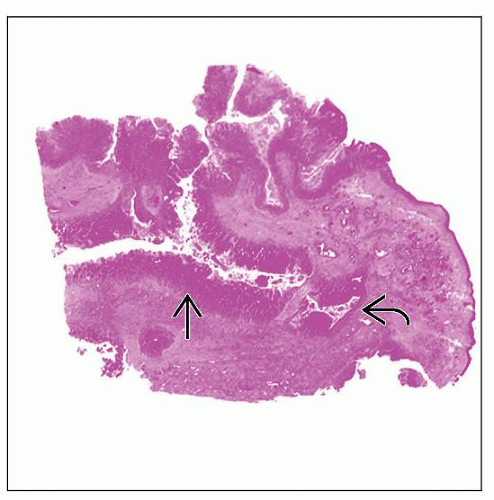Carcinoma Cuniculatum
Antonio L. Cubilla, MD
Alcides Chaux, MD
Elsa F. Velazquez, MD
Key Facts
Macroscopic Features
Large exoendophytic tumor with “cobblestone” appearance
Affects several anatomical compartments (glans, coronal sulcus, and foreskin)
Hallmark of lesion is seen upon sectioning: Deep endophytic and interanastomosing pattern mimicking rabbit burrows
Microscopic Pathology
In most cases, carcinoma cuniculatum is hybrid (mixed) verrucous carcinoma with peculiar deep growth pattern
Most of lesion is extremely well-differentiated (verrucous carcinoma)
Interanastomotic channels contain abundant keratin
Sinus tracts are commonly seen
Focal higher grade areas and infiltrative pattern are common (SCC of usual type)
Top Differential Diagnoses
Verrucous carcinoma
Lack higher grade areas and jagged borders
Lack classic burrowing pattern
Warty carcinoma
Prominent atypical koilocytosis
Papillary carcinoma
Lack classic burrowing pattern
Giant condyloma
Benign lesion with koilocytosis on surface
 Cut section of a partial penectomy specimen shows a carcinoma cuniculatum. Note the deep tumoral invagination following the tunica albuginea and involving the corpus cavernosum. |
TERMINOLOGY
Abbreviations
Carcinoma cuniculatum (CC)
Synonyms
Squamous cell carcinoma, hybrid verrucous carcinoma
Definitions
Distinct variant of verrucous carcinoma characterized by deep burrowing growth pattern mimicking rabbit burrows (cuniculi)
Represents hybrid (mixed) verrucous carcinoma with unique growth pattern
ETIOLOGY/PATHOGENESIS
Pathogenesis
Unknown
Likely not HPV-related
CLINICAL ISSUES
Epidemiology
Incidence
Very rare
Few cases described in literature
Age
Mean: 77 years
Site
Usually affects glans and extends to coronal sulcus and foreskin
Presentation
Large, papillomatous tumors with “cobblestone” appearance
Treatment
Surgery
Prognosis
Good prognosis
No reported metastases
MACROSCOPIC FEATURES
Stay updated, free articles. Join our Telegram channel

Full access? Get Clinical Tree





